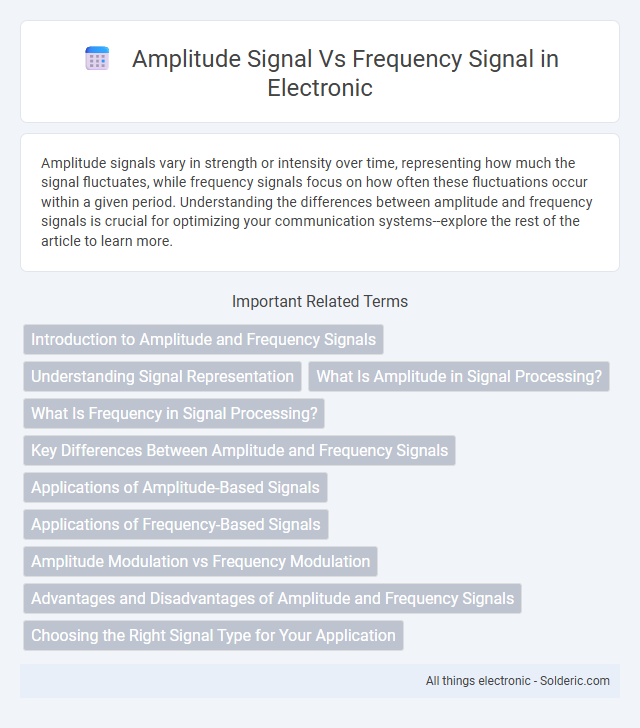Amplitude signals vary in strength or intensity over time, representing how much the signal fluctuates, while frequency signals focus on how often these fluctuations occur within a given period. Understanding the differences between amplitude and frequency signals is crucial for optimizing your communication systems--explore the rest of the article to learn more.
Comparison Table
| Feature | Amplitude Signal | Frequency Signal |
|---|---|---|
| Definition | Signal where information is encoded in amplitude variations. | Signal where information is encoded in frequency variations. |
| Modulation Type | Amplitude Modulation (AM) | Frequency Modulation (FM) |
| Signal Representation | Changes in signal height (amplitude) over time. | Changes in signal frequency over time. |
| Noise Sensitivity | High noise sensitivity, amplitude easily affected by interference. | Lower noise sensitivity, frequency remains stable under interference. |
| Bandwidth Requirement | Narrower bandwidth | Wider bandwidth |
| Spectrum Efficiency | Less spectrum efficient | More spectrum efficient |
| Application | AM radio, analog TV signals | FM radio, digital communication systems |
| Complexity | Simple transmitter and receiver design | More complex transmitter and receiver design |
Introduction to Amplitude and Frequency Signals
Amplitude signals represent variations in signal strength or intensity over time, crucial for encoding information in analog systems. Frequency signals describe changes in the rate at which a waveform oscillates, influencing signal transmission and data encoding in both analog and digital communications. Understanding the distinctions and applications of amplitude and frequency signals is fundamental for optimizing signal processing and communication system performance.
Understanding Signal Representation
Amplitude signals represent information through variations in signal strength or voltage levels, reflecting changes in intensity over time. Frequency signals encode data by modulating the rate at which the waveform oscillates, directly affecting the number of cycles per second measured in Hertz (Hz). Understanding these fundamental differences enables effective analysis and processing in telecommunications and signal processing applications.
What Is Amplitude in Signal Processing?
Amplitude in signal processing represents the magnitude or strength of a signal, indicating how much energy it carries at a given time. It directly influences the signal's power and is often measured in volts or decibels, making it crucial for determining signal clarity and volume. Unlike frequency, which defines the rate of oscillation, amplitude affects the signal's intensity and plays a vital role in amplitude modulation techniques and signal strength analysis.
What Is Frequency in Signal Processing?
Frequency in signal processing refers to the number of cycles a signal completes per second, measured in Hertz (Hz), representing how often the waveform repeats. It determines the pitch in audio signals or the rate of change in data transmission, crucial for analyzing and manipulating signals in communication systems. While amplitude indicates signal strength, frequency defines the signal's temporal characteristics and is essential for filtering, modulation, and spectral analysis.
Key Differences Between Amplitude and Frequency Signals
Amplitude signals vary in their signal strength or voltage level to represent information, making amplitude modulation (AM) sensitive to noise and signal degradation over distances. Frequency signals change the frequency of the carrier wave to encode data, resulting in frequency modulation (FM) which offers greater noise resistance and better sound quality. The key difference lies in the parameter each signal manipulates--amplitude modifies signal amplitude, while frequency adjusts signal frequency--impacting their application in communication systems.
Applications of Amplitude-Based Signals
Amplitude-based signals are widely used in applications such as audio transmission, where the strength of the signal determines sound volume, and in amplitude modulation (AM) radio broadcasting, which encodes information through varying signal power levels. These signals are crucial in medical devices like electrocardiograms (ECGs) to monitor heart activity by capturing amplitude fluctuations corresponding to heartbeat intensity. Your ability to interpret amplitude variations enables effective communication and precise monitoring in many electronic and communication systems.
Applications of Frequency-Based Signals
Frequency-based signals are crucial in telecommunications for encoding data in radio, television, and cellular networks, enabling efficient bandwidth usage and reduced interference. In medical imaging, frequency signals underpin technologies like MRI and ultrasound, providing detailed diagnostic images by analyzing signal frequencies. Industrial applications include vibration analysis and fault detection, where frequency signals identify mechanical issues in machinery through spectral analysis.
Amplitude Modulation vs Frequency Modulation
Amplitude Modulation (AM) varies the signal's amplitude to encode information while maintaining a constant frequency, making it susceptible to noise and signal degradation. Frequency Modulation (FM) changes the frequency of the carrier wave to convey data, offering improved noise resistance and better sound quality in your communication systems. Choosing between AM and FM depends on the required signal clarity, bandwidth availability, and application context.
Advantages and Disadvantages of Amplitude and Frequency Signals
Amplitude signals offer simple implementation and clear detection in analog communication but are highly susceptible to noise and signal degradation, reducing reliability. Frequency signals provide greater noise immunity and stable signal transmission, making them ideal for digital communication, though their complexity and bandwidth requirements are typically higher. Your choice between amplitude and frequency modulation should consider the trade-off between signal clarity and system complexity for optimal performance.
Choosing the Right Signal Type for Your Application
Amplitude signals vary in strength or intensity, making them ideal for applications requiring precise measurement of signal power or strength, such as audio processing and sensor readings. Frequency signals change in frequency, offering better noise immunity and stability, which suits communication systems and timing applications where accuracy and consistency are crucial. Understanding your application's need for signal fidelity, noise resistance, and data type helps determine whether amplitude or frequency signals optimize performance and reliability.
amplitude signal vs frequency signal Infographic

 solderic.com
solderic.com